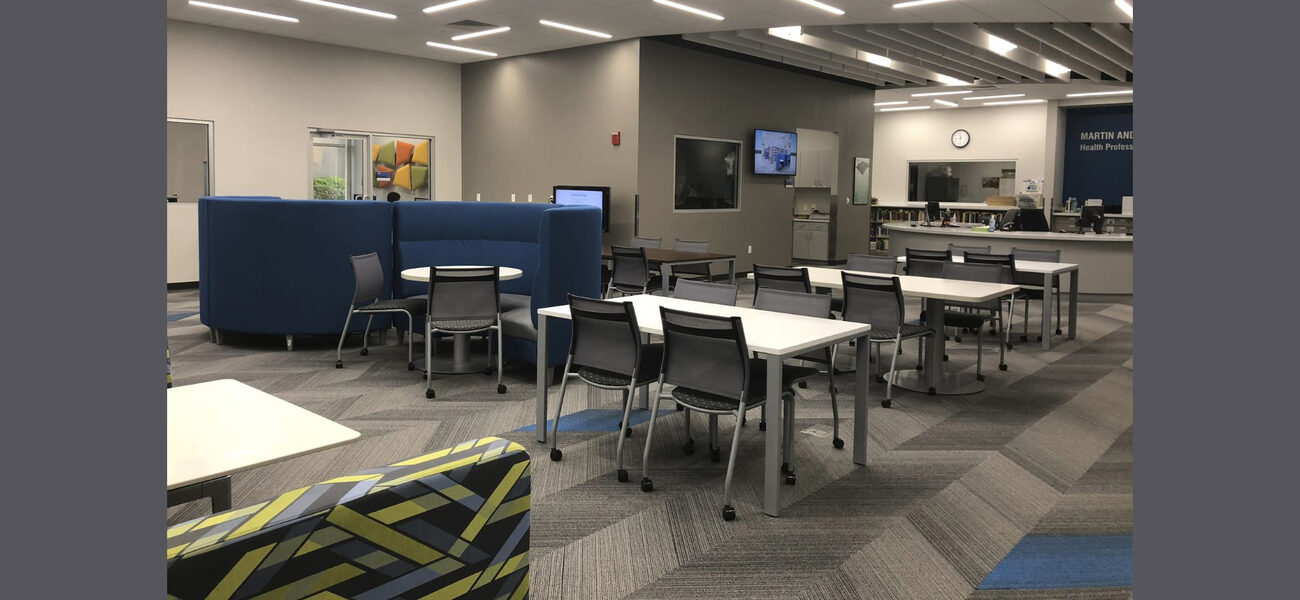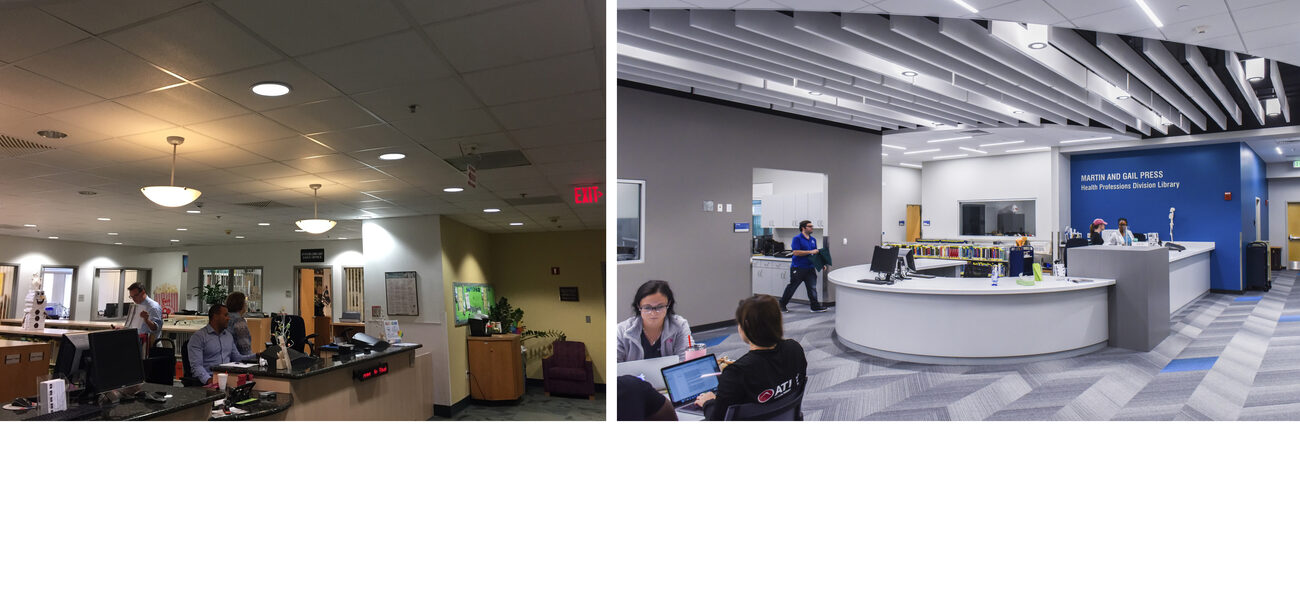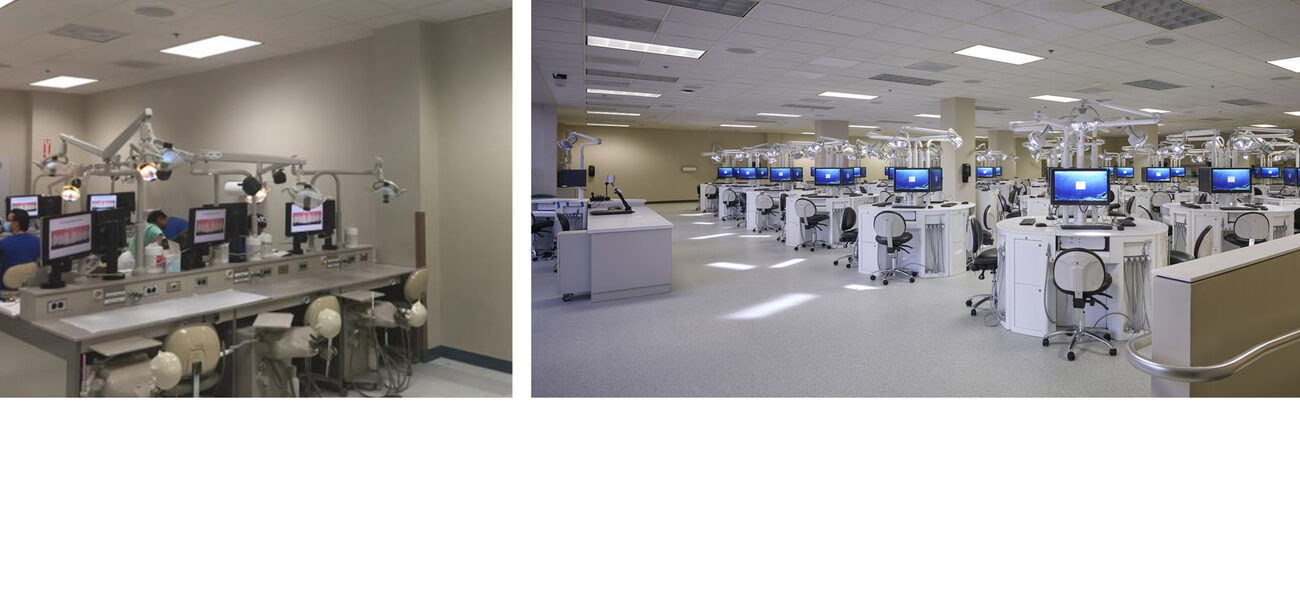Educating healthcare professionals in a manner that crosses disciplines and fosters teamwork for the advancement of public health is more than a mission statement for Nova Southeastern University (NSU) in Florida. It is an inherent objective in recent and ongoing construction projects on the main Davie Campus in Fort Lauderdale and at the regional campuses in Jacksonville; Miami; Miramar; Orlando; Palm Beach; Fort Myers; Tampa; and San Juan, Puerto Rico.
NSU undertakes construction and renovation projects with the goals of providing open spaces that promote collaboration; enhancing space utilization; creating healthy, comfortable environments for students, faculty, and staff; offering the most modern resources and technology for teaching and research; improving recruiting power; increasing efficiencies; lowering operating costs; and erasing departmental boundaries to eliminate the creation of silos, or “turfing.”
“As NSU grows and continues its vision of interdisciplinary education, the university wants collaborative spaces that promote innovation and that can be used for different programs,” says Betty Loynaz, associate principal for ACAI, which has served as campus architect for 25 years. “They want to give students a real-world experience, so that when they are healthcare providers, they can work effectively in a team environment to benefit the patients.”
The Health Professions Division (HPD) complex at the Davie Campus has undergone significant renovations to the dental simulation lab and the library since 2015, and work is currently under way on major projects at the HPD complex and in Tampa. ACAI continues to apply what it has learned about the university’s objectives as it plans more multimillion-dollar campus projects scheduled for completion through 2025.
Insights from Completed Projects
In order for ACAI to understand how the university can best provide students with a comfortable environment and the resources they need to be productive, students are regularly asked to express their opinions via surveys, town hall meetings, and other communications. Students want a variety of seating options, open spaces, and the ability to reconfigure spaces to suit their changing needs. Flexibility is a key component of facilities management projects at NSU, which is a private university with a large population of nontraditional students.
Since 1993, ACAI has worked on all buildings in the HPD complex and the regional campuses, with the most significant being the design of the Center for Collaborative Research (CCR), and the renovations of the dental simulation lab and the library, to make them more modern, user-friendly, and open.
“Where possible, we are removing walls to open spaces, and removing circulation square footage and unused storage space to create student collaboration and study areas,” says Loynaz. “We are installing new equipment and furniture with a reduced footprint and new technology.”
The HPD complex, which sits on approximately 19 of NSU’s 314 acres, consists of seven academic buildings and a parking garage. The six-story, 216,000-sf CCR, which opened in 2017, features wet and dry labs with innovative equipment and movable casework, a variety of collaboration spaces, and the resources necessary to conduct research in numerous disciplines, such as cancer, cell therapy, neuroimmune therapy, and restoration of the Florida Everglades. The building exterior features an entry rotunda, a clocktower, and a colonnade.
New buildings and renovation projects incorporate sustainable design, such as LED lighting fixtures with controls, sustainable materials, and recycling programs. New buildings are LEED-certified.
Renovation of the Dental Simulation Lab
The renovation of the dental simulation lab, located on the second floor of the Lab/Library Building, was completed in late 2015. Prior to the revamp, the lab was dark, lacked enough seating, and had no barrier to keep noise from traveling to the floor below.
Improvements included raising the floor; centralizing the air, water, and vacuum systems with distribution available to each student; changing the interior finishes to capture the natural daylight; and replacing the linear and square workstations with more compact, circular, individual pods. The ability to easily access the infrastructure offers flexibility for expanding the dental program.
The changes resulted in a 30 percent increase in seating and the capacity to increase it an additional 28 percent, when necessary. The layout of the work pods provides clear visual lines, so the professor can see all students. Technology includes electric hand drills, monitors, and mannequin heads that retract into the desks when not in use.
ACAI uses Building Information Modeling (BIM) with a laser scanner and the Construction Operations Building Information Exchange (COBie) in its design process. The scanner, which was used in the simulation lab, scans spaces and buildings to document existing conditions. The scans are translated into a model where the project is developed. BIM enables the design team to collaborate with users and other stakeholders to develop the best design solutions. COBie helps identify and track building assets to assist in building operations and maintenance.
Health Professions Division Library
The $4.1 million renovation of the HPD Library, completed in 2018, increased student seating by approximately 90 seats, or 37 percent; and created a sense of openness and engagement throughout the building—all without increasing the footprint.
“The overall capacity of the space was doubled by the addition of egress doors, which allow the space to be used for events and exhibits,” says Paul Pannier, associate principal at ACAI. “The students now have a variety of seating options, such as individual pods, carrel-like pods, tables for a few students, study rooms enclosed with glass, and large collaboration areas with flexible seating options that can be arranged to suit student needs. Rooms equipped with virtual reality technology and 3D printing also are available for student use.”
The original library featured a large circulation desk just inside the front door, underutilized space, bulky tables, inadequate seating, a lack of storage areas, insufficient collaboration and individual study spaces, a small space for students to get coffee, and many stacks of books.
The renovations included moving the circulation desk back; adding collaboration areas; incorporating more 3D and virtual technology; adding more seating and different types of seating; raising the ceiling to open the space, brightening the library with more colors; and installing lighting controls in various sections of the library. The building now can be used for events, such as receptions and fundraisers.
“The whole library is connected and engaged, but it feels cozy, and the pods make you feel like you are separated and not in the middle of everything,” says Loynaz. “It gives you a little privacy.”
The library project demonstrates why change management and buy-in are essential when many stakeholders are involved. Pannier notes there was resistance to removing books from the library, but touring other university libraries convinced NSU leaders that digital technology makes sense.
Master Plan for the Future
After seeing how much students enjoy the redesigned HPD Library, university officials decided to renovate the Alvin Sherman Library, the main library on campus. ACAI has already renovated two floors of the five-story, 323,000-sf building, and changes are planned for the remaining floors. The renovations will be like those made in the HPD Library to provide a variety of seating options, specialized spaces, and enhanced technology.
Other projects in design include a $300 million expansion of the HPD complex with the renovation of three buildings, and construction of a new academic tower and a new parking garage. All work is expected to be done by 2025.
“The HPD programs have grown significantly since the campus was built,” says Loynaz. “The academic tower and associated renovations will provide much needed space and allow for future growth.”
The new tower, which will connect to existing buildings, will be the new home of the osteopathic and allopathic medical programs, as well as the health care sciences, nursing, and dental programs. NSU has offered the osteopathic program, which assumes a holistic approach to medicine, since 1994. In 2017, it started its inaugural allopathic medicine program, or the study of traditional Western medicine.
“NSU is one of only three universities in the nation that has both allopathic and osteopathic medicine programs,” says Loynaz. “Both programs are housed at the Davie Campus, and there are unique spaces for each, but there are also spaces that can be shared, which promotes collaboration.”
The new academic tower will provide an increased amount of space for both medical programs. Additional space will be renovated to house clinical rotations in a building previously used by the Miami Dolphins as a training facility near the HPD complex.
NSU’s expansion also extends to its regional campuses, with the construction of a 325,000-sf building scheduled for completion at the new Tampa Bay Regional Campus in July 2019. The building, which features an atrium with a learning stair, collaboration spaces, study rooms, and a library, will house numerous medical programs. The new state-of-the art facility, costing over $200 million, will provide videoconferencing and virtual technology to enable real-time participation between students and professors in Tampa and Fort Lauderdale.
“In keeping with the university’s vision of interdisciplinary design, everything is going to be under one roof with as much shared space as possible,” says Loynaz. “This building is also designed to accommodate future growth.”
By Tracy Carbasho


